
Flax, also known as common flax or linseed, is a flowering plant, Linum usitatissimum, in the family Linaceae. It is cultivated as a food and fiber crop in regions of the world with temperate climates. Textiles made from flax are known in English as linen and are traditionally used for bed sheets, underclothes, and table linen. Its oil is known as linseed oil. In addition to referring to the plant, the word "flax" may refer to the unspun fibers of the flax plant. The plant species is known only as a cultivated plant and appears to have been domesticated just once from the wild species Linum bienne, called pale flax. The plants called "flax" in New Zealand are, by contrast, members of the genus Phormium.
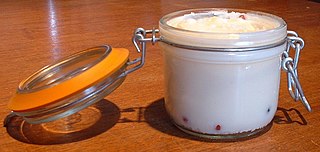
Tallow is a rendered form of beef or mutton fat, primarily made up of triglycerides.

Rapeseed, also known as oilseed rape, is a bright-yellow flowering member of the family Brassicaceae, cultivated mainly for its oil-rich seed, which naturally contains appreciable amounts of erucic acid. The term "canola" denotes a group of rapeseed cultivars that were bred to have very low levels of erucic acid and which are especially prized for use as human and animal food. Rapeseed is the third-largest source of vegetable oil and the second-largest source of protein meal in the world.
Erucic acid is a monounsaturated omega-9 fatty acid, denoted 22:1ω9. It has the chemical formula :CH3(CH2)7CH=CH(CH2)11CO2H. It is prevalent in wallflower seed and other plants in the family Brassicaceae, with a reported content of 20 to 54% in high erucic acid rapeseed oil and 42% in mustard oil. Erucic acid is also known as cis-13-docosenoic acid and the trans isomer is known as brassidic acid.
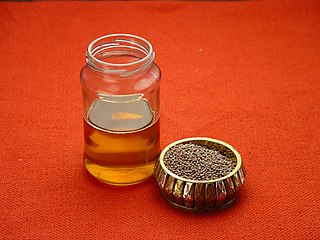
Mustard oil can mean either the pressed oil used for cooking, or a pungent essential oil also known as volatile oil of mustard. The essential oil results from grinding mustard seed, mixing the grounds with water, and isolating the resulting volatile oil by distillation. It can also be produced by dry distillation of the seed. Pressed mustard oil is used as cooking oil in some cultures, but sale is restricted in some countries due to high levels of erucic acid. Varieties of mustard seed also exist that are low in erucic acid.

Camelina is a genus within the flowering plant family Brassicaceae. The Camelina species, commonly known as false flax, are native to Mediterranean regions of Europe and Asia. Most species of this genus have been little studied, with the exception of Camelina sativa, historically cultivated as an oil plant. Heinrich Johann Nepomuk von Crantz was the first botanist to use the genus Camelina in his classification works in 1762. As a way to reduce fossil fuel emissions, the US Navy tested a 50-50 mix of jet aviation fuel and biofuel derived from camelina seeds in 2010. A study published in December 2016 explained that the current low price of conventional kerosene-based jet fuel makes it cost-prohibitive for commercial airlines to use camelina-based jet fuel. The study said substantial government intervention would be one way to create a market for camelina, by combining 9 percent government subsidy on camelina crop production, with 9 percent tax on conventional fuel.
Linola is the trademark name of solin, cultivated forms of flax bred for producing linseed oil with a low alpha-linolenic acid content. Linola was developed in the early 1990s by the Commonwealth Scientific and Industrial Research Organisation (CSIRO). It was developed and released in Australia in 1992 and first commercially grown in 1994. Australian Linola varieties are named after Australian lakes.
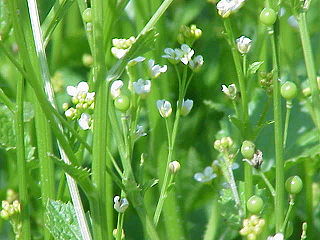
Crambe abyssinica is an annual oilseed crop of the family Brassicaceae. It is mainly cultivated due to the high levels of erucic acid that are contained in its seeds. The crambe oil is used for industrial purposes and its side products can be partly used as animal feed.

Perilla oil is an edible vegetable oil derived from perilla seeds. Having a distinct nutty aroma and taste, the oil pressed from the toasted perilla seeds is used as a flavor enhancer, condiment, and cooking oil in Korean cuisine. The oil pressed from untoasted perilla seeds is used for non-culinary purposes.
Camelina oil or False flax oil is a pressed seed oil, derived from the Camelina sativa or false flax, also called gold of pleasure. False flax has long been grown in Europe, and its oil used as a lamp oil until the 18th century. In recent times, it has been explored for use in cosmetic and skin care products. It has a high content of omega-3 and is used as a food supplement by some cultures. It is registered under the name "Olej rydzowy tradycyjny" as a Traditional Speciality Guaranteed product in the European Union and the United Kingdom.
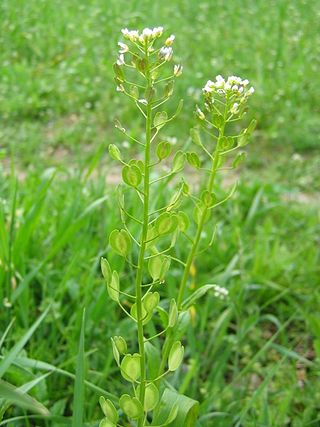
Thlaspi arvense, known by the common name field pennycress, is a flowering plant in the cabbage family Brassicaceae. It is native to Eurasia, and is a common weed throughout much of North America and its home.

Jatropha curcas is a species of flowering plant in the spurge family, Euphorbiaceae, that is native to the American tropics, most likely Mexico and Central America. It is originally native to the tropical areas of the Americas from Mexico to Argentina, and has been spread throughout the world in tropical and subtropical regions around the world, becoming naturalized or invasive in many areas. The specific epithet, "curcas", was first used by Portuguese doc Garcia de Orta more than 400 years ago. Common names in English include physic nut, Barbados nut, poison nut, bubble bush or purging nut. In parts of Africa and areas in Asia such as India it is often known as "castor oil plant" or "hedge castor oil plant", but it is not the same as the usual castor oil plant, Ricinus communis.
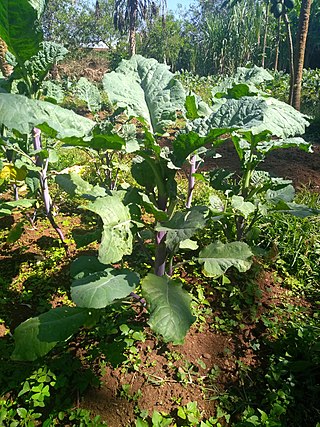
Brassica carinata is a species of flowering plant in the Brassicaceae family. It is referred to by the common names Ethiopian rape or Ethiopian mustard. It is believed to be a hybrid between Brassica nigra and Brassica oleracea.

An aviation biofuel or bio-jet fuel or bio-aviation fuel (BAF) is a biofuel used to power aircraft and is said to be a sustainable aviation fuel (SAF). The International Air Transport Association (IATA) considers it a key element to reducing the carbon footprint within the environmental impact of aviation. Aviation biofuel could help decarbonize medium- and long-haul air travel generating most emissions, and could extend the life of older aircraft types by lowering their carbon footprint.

Global Clean Energy Holdings (OTC:GCEH) is a Southern California-based renewable energy company with interests in the production and commercialization of non-food-based feedstocks used for the production of biofuels, biomass, and renewable chemicals. It was founded in 2007.

Sustainable Oils is a renewable fuels company specializing in the research and production of Camelina, the only advanced biofuels feedstock with United States Department of Agriculture, Environmental Protection Agency, and Food and Drug Administration (FDA) regulatory approvals. Oil extracted from Camelina seeds can be processed into a number of renewable products including renewable jet fuel, green diesel, biodiesel, green plastics and renewable oleochemicals. The biomass that remains after oil extraction, generally referred to seedcake or meal, can be used as nutrient-rich animal feed. Camelina offers several advantages over traditional biofuel feedstocks like soy and corn, such as competitive oil yields and shorter growing seasons. Sustainable Oils has its primary operations in the state of Montana and is headquartered in Great Falls.
An oilseed press is a machine that lies at the center of vegetable oil extraction. This is due to the fact that this technology is designed to release oil from oilseeds. Multiple oilseed press layouts have been developed over time to complete this process, with each having its own distinct set of advantages and disadvantages. Moreover, the products that are created by oilseed presses, namely oil and oilseed meal, possess great nutritive benefits for humans and livestock respectively. The oilseed press, being at the center of the oil-extraction process, is joined with various other pieces of equipment and procedures that form a pre- and post-extraction system.

The production of flax and other oilseed crops peak in the temperate climates of the middle mountain and hill farming regions in Nepal. Flax matures in approximately 90 to 125 days and develops most rapidly under the cool, short season of growing. The middle hill region of the Lamjung district exemplifies an ideal climate for flax production experiencing consistently cool temperatures for most of the year. The shallow rooting system makes the plant especially susceptible to drought and excess moisture in the soil but easier to harvest. Most cash crops are grown in the hill regions of Nepal as this is where two-thirds of the subsistence farmers reside, who need to produce just enough food to feed themselves and their families.
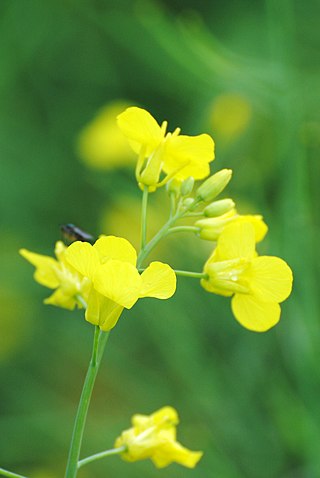
Rapeseed oil is one of the oldest known vegetable oils. There are both edible and industrial forms produced from rapeseed, the seed of several cultivars of the plant family Brassicaceae. Historically, it was restricted as a food oil due to its content of erucic acid, which in laboratory studies was shown to be damaging to the cardiac muscle of laboratory animals in high quantities and which imparts a bitter taste, and glucosinolates, which made it less nutritious in animal feed. Rapeseed oil from standard cultivars can contain up to 54% erucic acid.




















